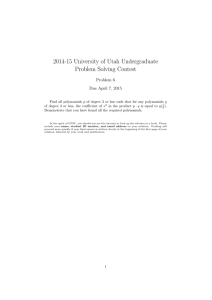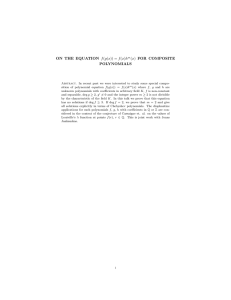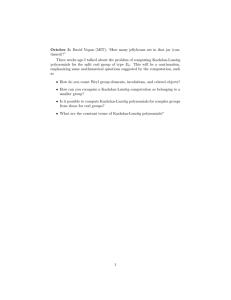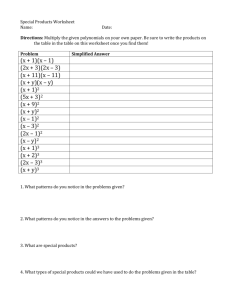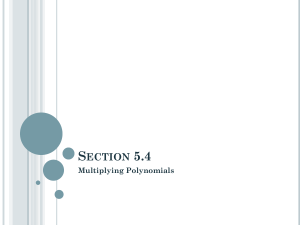pdf.
advertisement
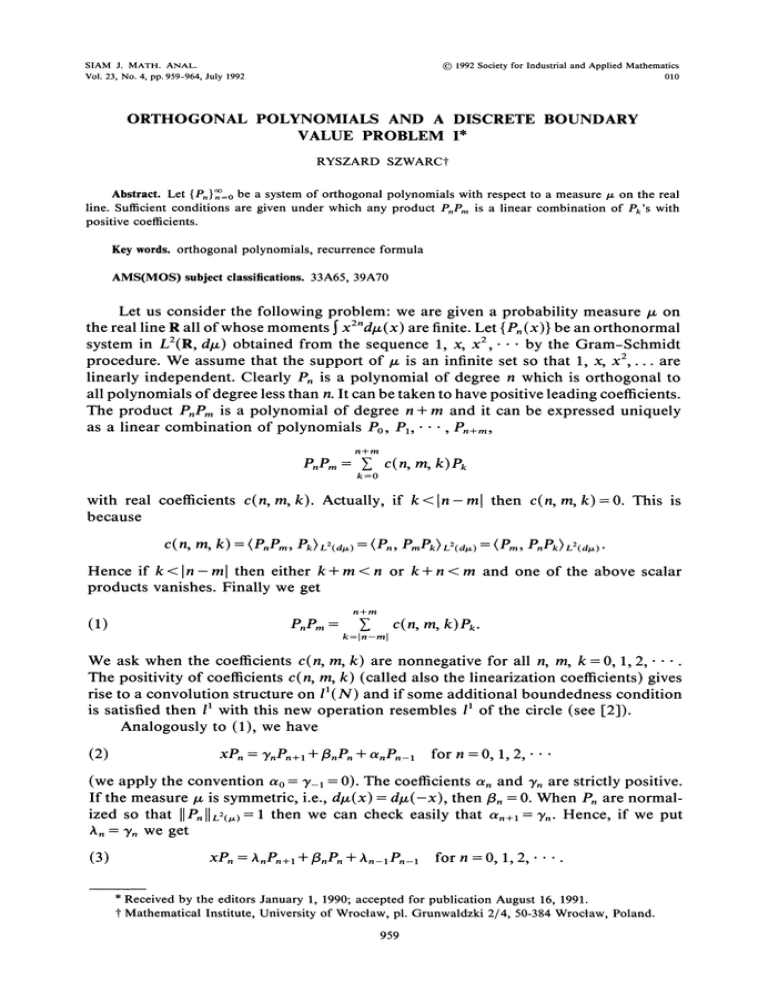
SIAM J. MATH. ANAL.
1992 Society for Industrial and Applied Mathematics
010
Vol. 23, No. 4, pp. 959-964, July 1992
ORTHOGONAL POLYNOMIALS AND A DISCRETE BOUNDARY
VALUE PROBLEM I*
RYSZARD SZWARC"
Abstract. Let {P.}.= be a system of orthogonal polynomials with respect to a measure/z on the real
line. Sufficient conditions are given under which any product P,,Pm is a linear combination of Pk’S with
positive coefficients.
Key words, orthogonal polynomials, recurrence formula
AMS(MOS) subject classifications. 33A65, 39A70
Let us consider the following problem: we are given a probability measure Ix on
the real line R all of whose moments x2"dix(x) are finite. Let {P, (x)} be an orthonormal
system in L2(R, dix) obtained from the sequence 1, x, x2,
by the Gram-Schmidt
We
that
the
of
assume
an
that 1, x, x2,.., are
infinite
is
so
set
procedure.
support
Ix
is
a
n
of
is orthogonal to
which
linearly independent. Clearly P,
polynomial
degree
all polynomials of degree less than n. It can be taken to have positive leading coefficients.
The product P, Pm is a polynomial of degree n + m and it can be expressed uniquely
as a linear combination of polynomials Po, P1,"" ",
n+m
P.P,,,= Y c(n, m, k)Pk
k=0
with real coefficients c(n, m, k). Actually, if k
<In-m
then c(n, m, k)=0. This is
because
c(n, m, k)=(P.Pm, Pk)L(d.)=(P., PPk)L=(d,)=(P,,,,
Hence if k < In ml then either k + m < n or k + n < m and one of the above scalar
products vanishes. Finally we get
.,
n+m
P, Pm=
(1)
c(n, m, k)Pk.
k=ln-ml
.
We ask when the coefficients c(n, m, k) are nonnegative for all n, m, k 0, 1, 2,
The positivity of coefficients c(n, m, k) (called also the linearization coefficients) gives
rise to a convolution structure on ll(N) and if some additional boundedness condition
is satisfied then with this new operation resembles of the circle (see [2]).
Analogously to (1), we have
xP
(2)
]/nPn+l +- nPn + OlnPn_
for n
O, 1, 2,..
(we apply the convention a0 y_ 0). The coefficients a, and y, are strictly positive.
If the measure tx is symmetric, i.e., dix(x)= dix(-x), then/3, 0. When P, are normalized so that IIP, IIL2(,) 1 then we can check easily that a,+= y,. Hence, if we put
A.
(3)
y. we get
xPn=lnPn+l’+nPn’+in_lPn_l forn=0, 1,2,.
..
* Received by the editors January 1, 1990; accepted for publication August 16, 1991.
? Mathematical Institute, University of Wroctaw, pl. Grunwaldzki 2/4, 50-384 Wroctaw, Poland.
959
960
RYSZARD SZWARC
Favard [4] proved that the converse is also true, i.e., any system of polynomials
satisfying (3) is orthonormal with respect to a probability measure/ (not necessarily
unique). In case of bounded sequences A, and/3, we can recover the measure /z in
the following way. Consider a linear operator L on 12(N) given by
.
n O, 1, 2,
La, A,a,+ + fl.a. + A._a,_,
Then L is a self-adjoint operator on l-(N). Let dE(x) be the spectral resolution
associated with L. Then the system {P,} is orthonormal with respect to the measure
d(x) d(E(x)6o, 60).
The statement of the positivity of c(n, m, k) does not require orthonormalization
of the polynomials P,. We can as well consider another normalization, i.e., let P, tr, P.
where tr, is a sequence of positive numbers. The problem of positive coefficients in
the product of P’s is equivalent to that of P’s. Moreover, it is easy to check that the
polynomials P, satisfy the recurrence relation of the form
(5)
xP. T.P.+ + fl.P. + otnPn_ for n 0, 1, 2,.
and the unique relation connecting a., y. and the coefficients A. from (3) is a.+ly. A2
the sequence of diagonal coefficients/3, remains unchanged. From this observation it
follows that if polyn.omials /3. satisfy (5) then after appropriate renormalization the
(4)
polynomials
P. c.P.
satisfy
xP. On+lPn+ + fl.P. + "yn_lPn_l
(6)
Consider the particular case of monic normalization, i.e., assume that the leading
coefficient of any P, is 1. Then the recurrence formula is
xP,,
(7)
P.+, + fl.P. + h_,P._,.
In 1970 Askey proved the following theorem concerning the monic case.
THEOREM (Askey 1 ]). Let P, satisfy (6) and let the sequences A, and ft, be increasing
(A, _-> 0); then the linearization coefficients in the formula
n+m
P,P,.=
Y.
c(n, m, k)Pk
k=ln-ml
are nonnegative.
This theorem applies to the Hermite, Laguerre, and Jacobi polynomials with
a +/3 _-> 1 (see [7]). However, it does not cover the symmetric Jacobi polynomials with
a =/3 when -1/2_-< a -< (and, in particular, the Legendre polynomials when a =/3 0).
Recall that the problem of positive linearization for Jacobi polynomials was completely
solved by Gaspar in [5] and [6]. In particular, c(n, m, k) are positive for a->_ fl and
a+fl+l_-->0.
The aim of this paper is to give a generalization of Askey’s result so it would
cover the symmetric Jacobi polynomials for a->_-1/2. One of the results is as follows.
THEOREM 1. If polynomials Pn satisfy
xP. e.P.+, + #.P. +
and
(i) a., ft., and a. + y. are increasing sequences y., a. >-0),
(ii) a.<- y. for n=O, 1,2,
then c(n. rn, k) >= 0 (see (1)).
It is remarkable that the assumptions on a.’s and 3’.’s are separated from that
...,
on
961
DISCRETE BOUNDARY VALUE PROBLEM
Before giving a proof let us explain how Askey’s theorem can be derived from
Theorem 1. If polynomials /3, satisfy the assumptions of Askey’s theorem then after
orthonormalization of P.’s we get the system of polynomials P, satisfying (3), i.e.,
xP.=A.P.++.P.+A._P._ forn=0, 1,2,. -,
and if h, and/3, are increasing then putting a, h,_l and %
that the assumptions of Theorem 1 are also satisfied.
Example. Consider the symmetric Jacobi polynomials
R’(1)- 1. They satisfy the following recurrence formula:
n + 2a + 1
2n +2a + 1
xR(,)
o(,) "tan+
h, we can see easily
R
’)
normalized by
n
2n +2a + 1
.tn_
In this case
n+2a+l
2n+2a+l
n
an 2n+2a+l’
Observe that a. + %
1 and
%
a. is increasing when a ->_
-.
/3.=0.
We have also a
% when
Instead of showing Theorem 1 we will prove a more general result.
THEOREM 2. Let polynomials P. satisfy
.
xP. %P.+l + fl.P. + a.P.-1
and let for some sequence
of positive numbers polynomials P. q.P. satisfy
xP. y’ P.+, + .P. +
1"
Assume also that
(i) fl fl. for any m n,
(ii) a < a’. for any m < n,
(iii) a + y a + y for any m < n 1,
(iv) a N y for any m n.
en the linearization coefficients c(n, m, k) in the formula
+m
P.Pm
c(n, m, k)Pk
are nonnegative.
a. and y y., we can easily see that Theorem 2 implies Theorem 1.
First observe that we have a.+ly. a’.+y. Moreover, by the remarks
preceding (6) we may assume that P. and P. satisfy
Setting a
Proof
xP. an+IPn+I + .P. +
xp. a’.+ ,p.+ + .P. + .- lP.-,
The rest of the proof will follow from the maximum principle for a discrete boundary
value problem.
Let L and L’ be linear operators acting on sequences {a.}.u by the rule
(8)
+,
962
RYSZARD SZWARC
Let Lm and L’. denote the operators acting on complex functions u(n, m), n, m N,
as L and L’ but with respect to the m- or n-variable treating the other variable as a
parameter.
Let us consider the following problem" N x N (n, m)
u(n, m) C and
(Ln-Lm)u--O’
u(n,O)>-O.
(9)
- -
THEOREM 3. Assume that a, > 0 for n >- 1 (we follow the convention ao a O) and
(i)
B’ for any m n,
(ii) am a’ for any m < n,
(iii) a,, + Ym <= a’, + 3" for any m < n 1,
(iv) a, <= 3", for any m <-- n.
Then u(n, m) >= 0 for m n.
Proof On the contrary, assume that u is negative at some points. Let (n, m + 1)
be the lowest point in the domain ((s, t): s t} for which u(n, m+ 1)<0. It means that
u(s, t) is nonnegative if t m. Consider the rectangular triangle with vertices A(n, m),
B(n-m, O) and C(n+ m, 0), as illustrated in Fig. 1.
m
m’
x)
n
I
m
o
I
m c m
I
o
m
o
FIG.
All lattice points in AABC we divide into two subsets" ’1, consisting of the points
n m(mod 2), and the rest 1]2. In the figure the points of
while the points of -2 are marked by U]. Let ’3 denote the lattice
are marked by
points connecting (n-m-1, 0) and (n, m+ 1) (except (n, m/ 1)) and f14 denote those
which connect (n+ m+ 1, 0) with (n, m+ 1) (except (n, m+ 1)). The points of 3 and
f4 are marked by and O, respectively.
Assume that (L’-Lm)u=O. Thus (,,,y)a, (L’-Lm)u(x,y)=O. If we calculate
the terms (L’,, L,,)u(x, y) 0 and we sum them up we will obtain a sum of the values
of the function u(s, t) with some coefficients c,, where (s, t) runs throughout the sets
’1 U 2 U ’3 U ’4 U {(n, m + 1)}. Namely,
(k, l) such that k-
E
0=
(Ln Lm)u(x, y)
(x,y) 1"
4
c.,u(s, t)+ Cn, m+lU(n, m + 1).
i=1
(s,t)
It is not hard to compute the coefficients c,, so we just list them below.
DISCRETE BOUNDARY VALUE PROBLEM
(i)
(ii)
(iii)
(iv)
(V)
963
(s, t)fl;
(s, t)f2; cs.,=a’s+T’-(a,+T,).
(s, t) f3 c,, y’(s, t)’4; Cs, t-- Olts--Olt
en, m+l=--am+l
By the assumptions of the theorem all coefficients c,t are nonnegative while C.,m+I is
strictly negative. Since u(s, t)>-O for (s, t)Ol .J -2 [-J 3 [,.J "4 and u(n, m+ 1) <0 then
the sum we were dealing with cannot be zero. It gives a contradiction.
Let us return to the proof of Theorem 2. Let P. and P. satisfy (8) and P. r.P.
for a strictly positive sequence tr.. If
n+m
P,,Pr,,
E
c(n, m, k)Pk,
k=ln-m
then
n+m
P.P,.
E
6(n,m,k)Pk,
k=ln-ml
where 6(n, m, k) c(n, m, k)tr,. Therefore in order to prove c(n, m, k) => 0 it suces to
show that (n, m, k) 0 for n > m. Since
L(P.Pm)= XP.Pm Lm(P.P)
and the polynomials P. are linearly independent then for any k the function u(n, m)
5(n, m, k) is a solution of (9). Obviously,
u(n, 0) c(n, 0, k),
0
if n k,
otherwise.
In paicular, u(n, 0)0. Hence by eorem 3 we get u(n, m)= (n, m, k) O. This
completes the proof of Theorem 2.
COROLLARY. Let polynomials P, satisfy xP, T,P,+I + fl,P, + a,P,-i and let
and a, be increasing (a, > 0 for n 1, ao O);
(i)
(ii) a + Y a,+l + Y,-1 for m < n 1;
(iii) a y, for m < n.
en the linearization coecients c(n, m, k) in (1) are nonnegative.
Proo By remarks preceding (6) after appropriate renormalization of P, we obtain
polynomials P satisfying (6). Then we get the required result by applying Theorem 2.
Example. Consider Jacobi polynomials P’. They satisfy the recurrence formula
,
xp,)_
2(n+l)(n+a+fl+l)
(2n + a + fl + 1)(2n + a + fl + 2) n+l
+
f12 2
(2n + a + fl)(2n + a + fl + 2)
2(n+a)(n+fl)
+
(2n+a+)(2n+a+fl+l)
p",)
Applying the corollary yields that for a fl and a + fl 0 we get positive linearization
coefficients. However, for a fl and a + fl < 0 the sequence
22
fl" (2n + a + )(2n + a + + 2)
fl
fl
964
RYSZARD SZWARC
is decreasing and we cannot apply any of the preceding results, although we know
from [5] and [6] that the condition a +/3 + 1->0 is sufficient.
In part II of this paper we will discuss the problem of positive linearization under
assumption/3n is decreasing when starting from n 1. This is more delicate because
assumptions on cn’s and y’s cannot be separated from those on fl’s.
REFERENCES
[2]
[3]
[4]
[5]
[6]
[7]
R. ASKEY, Linearization of the product of orthogonal polynomials, in Problems in Analysis, R. Gunning,
ed., Princeton University Press, Princeton, NJ, 1970, pp. 223-228.
, Orthogonal Polynomials and Special Functions, Regional Conference Series in Applied Mathematics 21, Society for Industrial and Applied Mathematics, Philadelphia, PA, 1975.
R. ASKEY AND G. GASPER, Linearization of the product of Jacobi polynomials. III, Canad. J. Math., 23
(1971), pp. 119-122.
J. FAVARD, Sur les polynmes de Tchebycheff, C. R. Acad. Sci. Paris, 200 (1935), pp. 2052-2055.
G. GASPER, Linearization of the product ofJacobi polynomials. I, Canad. J. Math., 22 (1970), pp. 171-175.
., Linearization of the product of Jacobi polynomials. II, Canad. J. Math., 22 (1970), pp. 582-593.
G. SZEG5, Orthogonal Polynomials, Fourth ed., Amer. Math. Soc. Colloq. Publ. 23, American Mathematical Society, Providence, RI, 1975.
